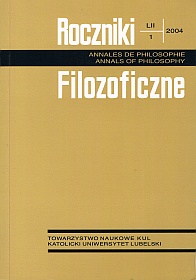Ascertaining the Causal Relationship in the Studies of the Effects of Weak Nonionizing Electromagnetic Fields on Embryogenesis of Man
Abstract
In a number of publications positive associations between the exposure to artificially generated nonionizing electromagnetic fields (EMF) and the reproductive risks in women were reported (abortion, birth defects, stillbirths). Yet, in another studies, claimed to be more careful, it has been shown that EMF should not be accounted for as a factor causing measurable increase in the above mentioned reproductive failures. In this context, of crucial importance is the determination whether the observed relationship between EMF and people is not of casual but of causal character.
In epidemiology a simple checklist is often used to establish this type of relationship. However, in the case of weak association the causal relationship may be claimed with a high degree of uncertainty. Taking into account the fact that in situations that are of interest to epidemiology, EMF are one (sometimes seemingly the most important) of a number of factors. Therefore, the above mentioned bioeffects may come into effect only if other factors are also present. It should be also stressed that the intricacy of these relationships increases when the role of such circumstances, as: distribution in time of the expositions, accumulation of dose, different spans of latency periods, as well as possible stimulatory effects of weak EMF is taken into account.
References
Aniołczyk H. 1990: Ekspozycja zawodowa na pola elektromagnetyczne ekstremalnie niskiej częstotliwości (ze szczególnym uwzględnieniem energetyki) a stan zdrowia pracowników na podstawie przeglądu piśmiennictwa, „Medycyna Pracy”, 1, s. 25-33.
Becker R.O., Selden G. 1994: Elektropolis, Elektromagnetyzm i podstawy życia, tłum. z ang., Warszawa: Instytut Wydawniczy PAX – Fundacja Bioelektroniki.
Bracken M.B., Belanger K., Hellenbrand K., Dlugosz L., Holford T.R., McSharry J.E., Addesso K., Leaderer B. 1995: Exposure to electromagnetic fields during pregnancy with emphasis on electrically heated beds: Association with birthweight and intrauterine growth retardation, „Epidemiology”, 6, s. 263-270.
Brandt L.P.A., Nielsen C.V. 1990a: Congenital malformations among children of women working with video display terminals, „Scandinavian Journal of Work, Environment & Health”, 16, s. 329-333.
Brandt L.P.A., Nielsen C.V. 1990b: Spontaneous abortion among women using video display terminals, „Scandinavian Journal of Work, Environment & Health”, 16, s. 323-328.
Breysse P., Lees P.S.L., McDiarmid M.A., Curbow B. 1994: ELF magnetic field exposure an office environment, „American Journal of Medicine”, 25, s. 463-475.
Charlton B.G. 1996: Attribution of causation in epidemiology: chain or mosaic?, „Journal of Clinical Epidemiology”, 49, s. 105-107.
Ericson A., Källén B. 1986a: An epidemiological study of work with video screens and pregnancy outcome: I. A registry study, „American Journal of Industrial Medicine”, 9, s. 447-457.
Ericson A., Källén B. 1986b: An epidemiological study of work with video screens and pregnancy outcome: II. A case-control study, „American Journal of Industrial Medicine”, 9, s. 459-475.
Goldhaber M.K., Polen M.R., Hiatt R.A. 1988: The risk of miscarriage and birth defects among women who use visual display terminals during pregnancy, „American Journal of Industrial Medicine”, 13, s. 695-706.
Hendee W. R., Boteler J.C. 1994: The question of health effects from exposure to electromagnetic fields. „Health Physics”, 66, s. 127-136.
Hill B. A. 1965: The environment and disease: association or causation? „Proceedings of the Royal Society of Medicine”, 58, s. 295-300.
Jabłoński L. 1996, Epidemiologia, Lublin: Wydawnictwo Folium.
Jędrychowski W. 1986: Epidemiologia. Wprowadzenie i metody, Warszawa: PZWL.
Jędrychowski W. 1999: Epidemiologia. Wprowadzenie i metody badań, Warszawa: PZWL.
Juutilainen J., Matilainen P., Saarikoski S., Läärä E., Suonio S. 1993: Early pregnancy loss and exposure to 50-Hz magnetic fields, „Bioelectromagnetics”, 14, s. 229-236.
Korniewicz H. 1996: Pola elektromagnetyczne instalacji elektrycznej, „Bezpieczeństwo Pracy”, 4, s. 20-22.
Lee G.M., Neutra R.R., Hristova L., Yost M., Hiatt R. A. 2002: A nested case-control study of residential and personal magnetic field measures and miscarriages, „Epidemiology”, 13, s. 21-31.
Leśkiewicz J., Poświata A. 1997: Oddziaływanie fal elektromagnetycznych na otoczenie, „Aura”, 1, s. 4-7.
Marciniak J. 1995: Zagrożenie naturalnego środowiska elektromagnetycznego, Gliwice: Wydawnictwo Politechniki Śląskiej.
Mikołajczyk H. 1974: Pola elektromagnetyczne, Warszawa: PWN.
Minecki L. 1972: Promieniowanie elektro-magnetyczne wielkiej częstotliwości, Warszawa: Instytut Wydawniczy CRZZ.
Pearl J. 1988: Probabilistic reasoning in intelligent systems: Networks of plausible inference, San Francisco AC: Morgan Kaufman.
Pearl J. 2000: Causality: Models, reasoning, and inference, Cambridge: Cambridge University Press.
Presman A. S. 1971: Pola elektromagnetyczne a żywa przyroda, (tłum. z ros.), Warszawa: PWN.
Rothman K. J. 1976: Causes, „American Journal of Epidemiology”, 104, s. 587-592.
Schnorr T.M., Grajewski B.A., Hornung R.W., Thun M. J., Egeland G.M., Murray W.E., Conover D.L., Halperin W.E. 1991: Video display terminals and the risk of spontaneous abortion, „The New England Journal of Medicine”, 324, s. 727-733.
Singewald J.L., Langworthy O.R., Kouwenhoven W.B. 1973: Medical follow-up study of high voltage lineman working in AC electric fields, „IEEE Trans Power App Syst”, 92, s. 1307-1309.
Vineis P. 1991: Causality assessment in epidemiology, „Theoretical Medicine”, 12, s. 171-181.
Weed D.L. 1997: On the use of causal criteria, „International Journal of Epidemiology”, 26, 6, s. 1137-1140.
Windham G.C., Fenster L., Swan S.H., Neutra R.R. 1990: Use of video display terminals during pregnancy and the risk of spontaneous abortion, low birthweight, or intrauterine growth retardation, „American Journal of Industrial Medicine”, 18, s. 675-688.
Wynder E.L., Higgins I.T., Harris R.E. 1990: The wish bias, „Journal of Clinical Epidemiology”, 43, s. 619-621.
Zmyślony M., Aniołczyk H. 1994: Horyzontowe linie radiowe – weryfikacja systemu nadzoru, „Bezpieczeństwo Pracy”, 1-2, s. 12-15.
Zon J. 1976: Wpływ naturalnego środowiska elektromagnetycznego na człowieka, „Roczniki Filozoficzne”, 24, z. 3, s. 89-100.
Copyright (c) 2004 Roczniki Filozoficzne

This work is licensed under a Creative Commons Attribution-NonCommercial-NoDerivatives 4.0 International License.





